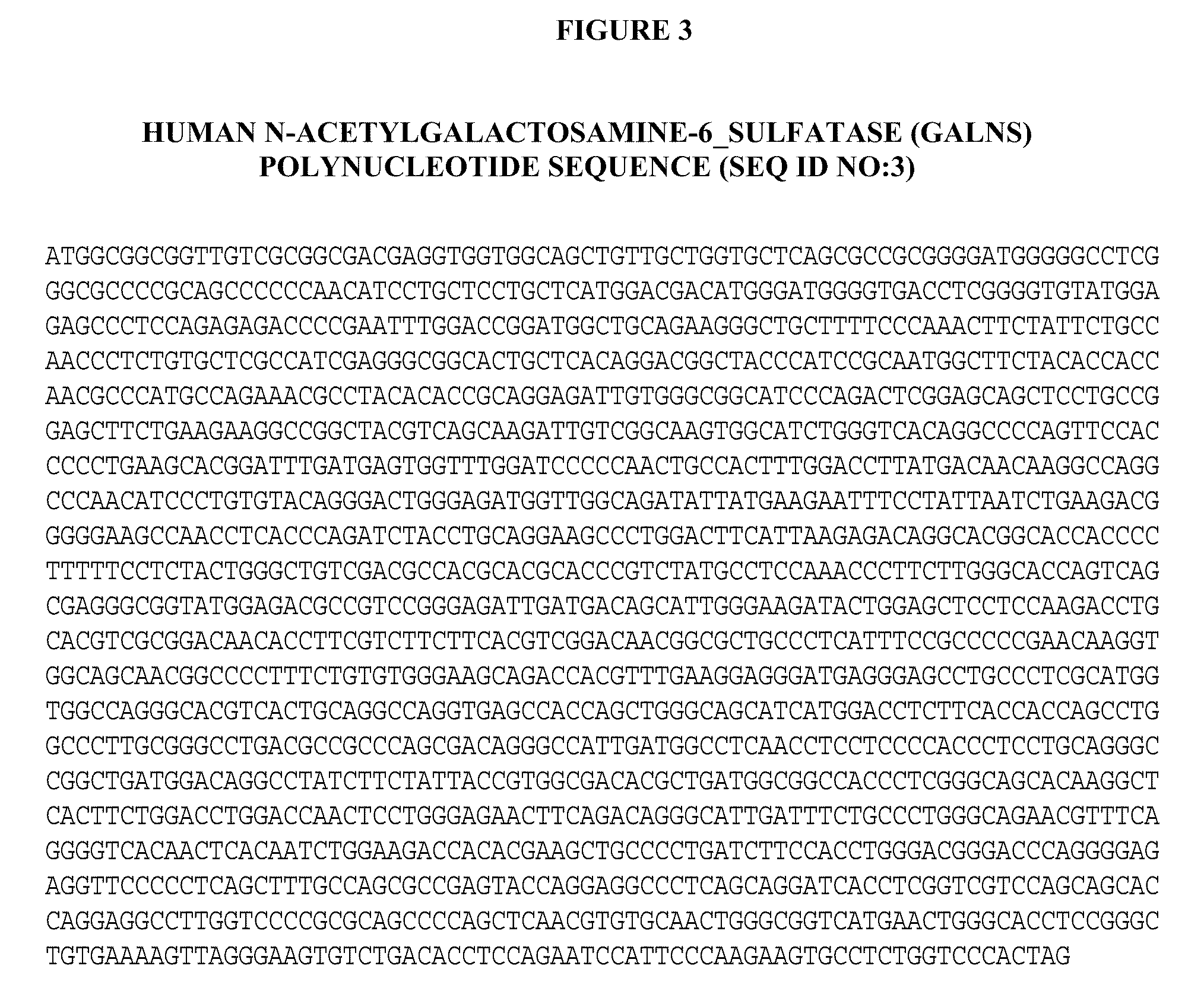Manufacture of active highly phosphorylated human lysosomal sulfatase enzymes and uses thereof
a highly phosphorylated, enzyme technology, applied in the field of cell and molecular biology and medicine, can solve the problems of lysosome swelling and malfunction, and ultimately cellular and tissue damage, and achieve high yield of active, high yield of active highly phosphorylated enzymes, and prevent material loss
- Summary
- Abstract
- Description
- Claims
- Application Information
AI Technical Summary
Benefits of technology
Problems solved by technology
Method used
Image
Examples
example i
Mammalian Expression Vectors for Human Sulfatase Modifying Factor1 (SUMF1) and Human N-Acetylgalactosamine-6-Sulfatase (GALNS)
[0222]The objective was to construct mammalian expression vectors appropriate for producing in stably transfected cells adequate amounts of active lysosomal sulfatase enzymes with improved phosphorylation levels.
[0223]The full-length human sulfatase modifying factor 1 (SUMF1) cDNA (see United States Patent Application Nos. US 20005 / 0123949, publication date Jun. 9, 2005, and US 2004 / 0229250, publication date Nov. 8, 2004, both of which are herein incorporated by reference in their entirety), which encodes a 374 amino acid polypeptide, was cloned into the mammalian expression vector cDNA4 (Invitrogen, Carlsbad, Calif.), which contains the human CMV enhancer-promoter and a multiple cloning site. Efficient transcript termination was ensured by the presence of the bovine growth hormone polyadenylation sequence. The selection marker was a zeocin resistance gene un...
example ii
G71S Cell Lines Co-Expressing Human Sulfatase Modifying Factor1 (SUMF1) and Human N-Acetylgalactosamine-6-Sulfatase (GALNS)
[0233]The objective was to develop cell lines capable of producing active lysosomal sulfatase enzymes with improved phosphorylation levels.
[0234]G71 cells (Rockford K. Draper) were derived directly from CHO-K1 (ATCC CCL-61). The G71 cell line is a temperature-sensitive mutant of CHO-K1 with respect to acidification of the endosomes, which has been observed to yield differences in total protein secretion and phosphorylation on mannose residues for several enzymes at elevated temperatures (Park et al., Somat. Cell Mol. Genet. 17(2): 137-150, 1991; Marnell et al., J. Cell. Biol. 99(6): 1907-1916, 1984).
[0235]G71 cells were maintained at 34° C. in BioWhittaker UltraCHO medium supplemented with 2.5% fetal calf serum, 2 mM glutamine, gentamycin and amphotericin.
[0236]To allow easier use of cell lines for protein production, the adherent G71 cells were pre-adapted to s...
example iii
Large-Scale Culture of G71S Cell Lines Expressing Human N-Acetylgalactosamine-6-Sulfatase (GALNS)
[0243]The objective was to measure enzyme production from the G71S clones expressing human N-acetylgalactosamine-6-sulfatase (GALNS). Serum-free suspension culture adapted G71S cell lines co-expressing human SUMF1 and human GALNS were cultured in large-scale and assessed for active GALNS enzyme production.
[0244]Since adaptation to serum-free suspension culture was relatively quick for the G71S host cell line, it was decided that production could be done in a WAVE bioreactor operated in perfusion mode. The WAVE bioreactor allows greater flexibility in inoculum volume because scale-up can be done directly in the bag, reducing the risk of contamination and expediting the production of material. FIG. 7 shows the schematic of WAVE bioreactor setup. The diagram shows, in perfusion mode, that a load cell monitors the media volume in the bag by determining the weight of the bag and adjusting the...
PUM
| Property | Measurement | Unit |
|---|---|---|
| pH | aaaaa | aaaaa |
| pH | aaaaa | aaaaa |
| permissive temperatures | aaaaa | aaaaa |
Abstract
Description
Claims
Application Information
 Login to View More
Login to View More - R&D
- Intellectual Property
- Life Sciences
- Materials
- Tech Scout
- Unparalleled Data Quality
- Higher Quality Content
- 60% Fewer Hallucinations
Browse by: Latest US Patents, China's latest patents, Technical Efficacy Thesaurus, Application Domain, Technology Topic, Popular Technical Reports.
© 2025 PatSnap. All rights reserved.Legal|Privacy policy|Modern Slavery Act Transparency Statement|Sitemap|About US| Contact US: help@patsnap.com



